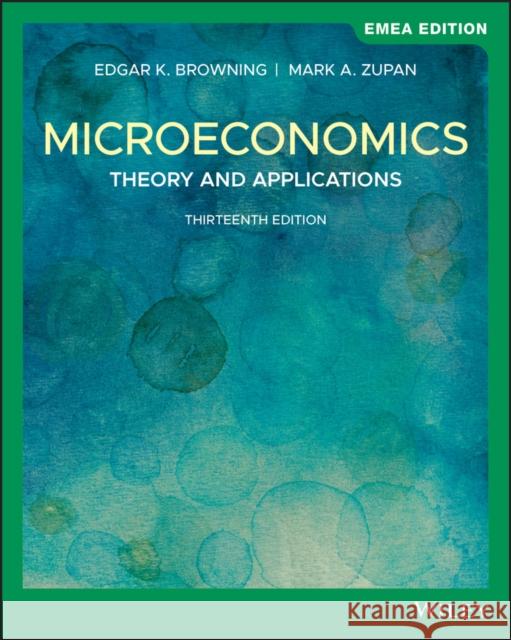Microeconomics » książka



Microeconomics
ISBN-13: 9781119668749 / Angielski / Miękka / 2020 / 592 str.
Microeconomics
ISBN-13: 9781119668749 / Angielski / Miękka / 2020 / 592 str.
(netto: 261,85 VAT: 5%)
Najniższa cena z 30 dni: 274,38
ok. 30 dni roboczych
Dostawa w 2026 r.
Darmowa dostawa!
Preface iiiAcknowledgments viiiChapter 1: An Introduction to Microeconomics 11.1 The Scope of Microeconomic Theory 21.2 The Nature and Role of Theory 21.3 Positive versus Normative Analysis 31.4 Market Analysis and Real versus Nominal Prices 41.5 Basic Assumptions about Market Participants 51.6 Opportunity Cost 61.7 Production Possibility Frontier 9Chapter 2: Supply and Demand 132.1 Demand and Supply Curves 142.2 Determination of Equilibrium Price and Quantity 212.3 Adjustment to Changes in Demand or Supply 222.4 Government Intervention in Markets: Price Controls 252.5 Elasticities 30Chapter 3: The Theory of Consumer Choice 423.1 Consumer Preferences 433.2 The Budget Constraint 523.3 The Consumer's Choice 563.4 Changes in Income and Consumption Choices 613.5 Are People Selfish? 673.6 The Utility Approach to Consumer Choice 69Chapter 4: Individual and Market Demand 754.1 Price Changes and Consumption Choices 764.2 Income and Substitution Effects of a Price Change 804.3 Income and Substitution Effects: Inferior Goods 854.4 From Individual to Market Demand 884.5 Consumer Surplus 894.6 Price Elasticity and the Price-Consumption Curve 954.7 Network Effects 974.8 The Basics of Demand Curve Estimation 100Chapter 5: Using Consumer Choice Theory 1075.1 Excise Subsidies, Health Care, and Consumer Welfare 1085.2 Subsidizing Health Insurance: ObamaCare 1125.3 Public Schools and the Voucher Proposal 1165.4 Paying for Garbage 1215.5 The Consumer's Choice to Save or Borrow 1245.6 Investor Choice 130Chapter 6: Exchange, Efficiency, and Prices 1406.1 Two-Person Exchange 1416.2 Efficiency in the Distribution of Goods 1476.3 Competitive Equilibrium and Efficient Distribution 1516.4 Price and Nonprice Rationing and Efficiency 154Chapter 7: Production 1607.1 Relating Output to Inputs 1617.2 Production When Only One Input is Variable: The Short Run 1617.3 Production When All Inputs are Variable: The Long Run 1677.4 Returns to Scale 1737.5 Functional Forms and Empirical Estimation of Production Functions 176Chapter 8: The Cost of Production 1828.1 The Nature of Cost 1838.2 Short-Run Cost of Production 1838.3 Short-Run Cost Curves 1868.4 Long-Run Cost of Production 1928.5 Input Price Changes and Cost Curves 1978.6 Long-Run Cost Curves 1998.7 Learning by Doing 2028.8 Importance of Cost Curves to Market Structure 2048.9 Using Cost Curves: Controlling Pollution 2068.10 Economies of Scope 2088.11 Estimating Cost Functions 209Chapter 9: Profit Maximization in Perfectly Competitive Markets 2139.1 The Assumptions of Perfect Competition .2149.2 Profit Maximization 2159.3 The Demand Curve for a Competitive Firm 2179.4 Short-Run Profit Maximization 2189.5 The Perfectly Competitive Firm's Short-Run Supply Curve 2239.6 The Short-Run Industry Supply Curve 2269.7 Long-Run Competitive Equilibrium 2279.8 The Long-Run Industry Supply Curve 2319.9 When Does the Competitive Model Apply? 239Chapter 10: Using the Competitive Model 24410.1 The Evaluation of Gains and Losses 24410.2 Excise Taxation 25010.3 Airline Regulation and Deregulation 25810.4 City Taxicab Markets 26310.5 Consumer and Producer Surplus, and the Net Gains from Trade 26710.6 Government Intervention in Markets: Quantity Controls 271Chapter 11: Monopoly 27911.1 The Monopolist's Demand and Marginal Revenue Curves 28011.2 Profit-Maximizing Output of a Monopoly 28211.3 Further Implications of Monopoly Analysis 28711.4 The Measurement and Sources of Monopoly Power 29011.5 The Efficiency Effects of Monopoly 29711.6 Public Policy toward Monopoly 300Chapter 12: Product Pricing with Monopoly Power 30812.1 Price Discrimination 30912.2 Three Necessary Conditions for Price Discrimination 31312.3 Price and Output Determination with Price Discrimination 31512.4 Intertemporal Price Discrimination and Peak-Load Pricing 31812.5 Two-Part Tariffs 324Chapter 13: Monopolistic Competition and Oligopoly 33213.1 Price and Output under Monopolistic Competition 33313.2 Oligopoly and the Cournot Model 33813.3 Other Oligopoly Models 34213.4 Cartels and Collusion 347Chapter 14: Game Theory and theEconomics of Information 36014.1 Game Theory 36114.2 The Prisoner's Dilemma Game 36414.3 Repeated Games 36914.4 Asymmetric Information 37314.5 Adverse Selection and Moral Hazard 37714.6 Limited Price Information 38114.7 Advertising 383Chapter 15: Using Noncompetitive Market Models 38915.1 The Size of the Deadweight Loss of Monopoly 38915.2 Do Monopolies Suppress Inventions? 39315.3 Natural Monopoly 39615.4 More on Game Theory: Iterated Dominance and Commitment 400Chapter 16: Employment and Pricing of Inputs 40616.1 The Input Demand Curve of a Competitive Firm 40716.2 Industry and Market Demand Curves for an Input 41216.3 The Supply of Inputs 41516.4 Industry Determination of Price and Employment of Inputs 41716.5 Input Price Determination in a Multi-Industry Market 42016.6 Input Demand and Employment by an Output Market Monopoly 42216.7 Monopsony in Input Markets 424Chapter 17: Wages, Rent, Interest, and Profit 42917.1 The Income-Leisure Choice of the Worker 42917.2 The Supply of Hours of Work 43217.3 The General Level of Wage Rates 43717.4 Why Wages Differ 43917.5 Economic Rent 44317.6 Monopoly Power in Input Markets: The Case of Unions 44517.7 Borrowing, Lending, and the Interest Rate 44817.8 Investment and the Marginal Productivity of Capital 44917.9 Saving, Investment, and the Interest Rate 45217.10 Why Interest Rates Differ 454Chapter 18: Using Input Market Analysis 45718.1 The Minimum Wage 45818.2 Who Really Pays for Social Security? 46418.3 The Hidden Cost of Social Security 46718.4 The NCAA Cartel 47018.5 Discrimination in Employment 47618.6 The Benefits and Costs of Immigration 480Chapter 19: General Equilibrium Analysis and Economic Efficiency 48619.1 Partial and General Equilibrium Analysis Compared 48719.2 Economic Efficiency 49019.3 Conditions for Economic Efficiency 49219.4 Efficiency in Production 49219.5 The Production Possibility Frontier and Efficiency in Output 49619.6 Competitive Markets and Economic Efficiency 50119.7 The Causes of Economic Inefficiency 504Chapter 20: Public Goods and Externalities 50920.1 What are Public Goods? 51020.2 Efficiency in the Provision of a Public Good 51220.3 Externalities 51620.4 Externalities and Property Rights 52220.5 Controlling Pollution, Revisited 524The Market for Los Angeles Smog 527Answers to Selected Problems 532Glossary G-1Index 1
1997-2025 DolnySlask.com Agencja Internetowa
KrainaKsiazek.PL - Księgarnia Internetowa









